|
The
Last Salute: Civil and Military Funeral, 1921-1969
CHAPTER XIV
The Unknown Soldiers
of World War II
and the Korean War State Funeral
12-30 May 1958
In June 1946 the 79th Congress
passed a bill which became Public Law 429, sponsored by Congressman
Charles M. Price, Democrat of Illinois, authorizing the burial in Arlington
National Cemetery of the body of an unknown serviceman killed in World
War II. Not until 23 July 1948, however, did the Department of the Army
issue orders calling for the selection of the unknown serviceman. By
15 March 1951, the body of one unidentified serviceman was to be chosen
from each of the following: the European area, the Far East area, the
Mediterranean zone, the Pacific area, and the former Africa-Middle East
zone, now part of the Mediterranean zone. The bodies were to be brought
to Washington, D.C., by 28 May 1951, when the President was to choose
the unknown serviceman to be honored.
Changes were made in the
orders over the next two years. It was decided that an unknown serviceman
would also be brought from the Alaska Command. The unknown serviceman
was not to be chosen in Washington, but at Independence Hall in Philadelphia.
The selection was to be made, not by the President, but by one of five
representatives of the Army, Navy, Air Force, Marine Corps, and Coast
Guard, each of whom had received the highest award of his service during
World War II. The method of choosing the selector was to be decided
by the five services and the selection ceremony was now scheduled for
26 May 1951. After the selection, the body of the chosen unknown serviceman
was to be taken to Washington on 27 May, to lie in state in the Capitol
through 29 May, and to be buried in Arlington National Cemetery on the
morning of 30 May. All these plans were canceled upon the outbreak of
hostilities in Korea in June 1950.
Interest in the project
was revived after the Korean War. In August 1955, largely at the urging
of various veterans' organizations, Secretary of Defense Charles E.
Wilson asked the Department of the Army to proceed with plans to select
an unknown serviceman of World War II. A year later, on 3 August 1956,
the 84th Congress enacted Public Law 975, a measure also sponsored by
Congressman Price of Illinois, authorizing the burial of an unknown
serviceman of the Korean War in Arlington National Cemetery.
[93]
The Department of the Army
drafted new, simplified plans for selecting the unknown servicemen of
World War II and the Korean War. All services would participate. The
Air Force was to choose one of the unknown war dead to represent the
transpacific phase of World War II, and the Army was to choose one to
represent the transatlantic phase. The Navy was to select one of these
two and transport the body to Washington for burial. At the same time,
the Navy was to bring one of the unknown dead of the Korean War, who
was to be selected by the Army in Hawaii.
Secretary of Defense Wilson
approved the Department of the Army plan on 31 December 1956 and directed
that two of the unknown dead of World War II buried overseas be selected
with appropriate ceremonies by 15 May 1958. The Commander in Chief,
U.S. Army, Europe, was to select one from the European theater; the
Commanding General, Far East Air Forces, one from the Pacific theater.
A naval officer, to be designated by the Chief of Naval Operations,
was to choose the World War II unknown serviceman from the two. All
selections were to be made outside the United States, the Navy's part
in the proceedings to take place at sea.
The Commanding General,
US Army, Pacific, was meanwhile to select in Hawaii an unknown serviceman
of the Korean War. The Navy was to transport both of the dead servicemen
to Washington by 27 May 1958. There the two were to lie in state until
30 May, when, after a joint funeral, both were to be buried in Arlington
National Cemetery next to the Unknown Soldier of World War I.
The Quartermaster General
of the Army, Maj. Gen. Andrew T. McNamara, was designated coordinator
and on 18 September 1957 he directed the commands involved to prepare
detailed plans for selecting the unknown dead. Representatives of all
the armed forces were to participate and ceremonies were to be simple
and dignified.
The Commanding General,
Military District of Washington, Maj. Gen. John G. Van Houten, was charged
with arranging the ceremonies in Washington. General Van Houten began
his planning on 17 January 1957 for the ceremonies attending the arrival
of the dead, the lying in state at the Capitol, the funeral procession
and service, and burial at the Tomb of the Unknown Soldier. He was assisted
by a planning staff, eventually organized as the Interment of the Unknowns
Working Group, which consisted of a liaison officer from each service
including the Coast Guard in addition to officers of his own command.
(Chart 1)
By 15 August
1957 all sites for the various ceremonies had been chosen. One result
of the planning was a determination that two crypts, rather than new
tombs, would be prepared for the unknown dead. Construction of the crypts
was to begin on 12 November 1957 and to be completed by 5 May 1958.
On 7 November 1957 a full
draft plan had been completed and was circulating among the services
for comment and concurrence. The plan was returned with a few comments
from the Air Force; the other services approved without com-
[94]
CHART
1 - ORGANIZATIONAL RESPONSIBILITY FOR BURIAL CEREMONIES OF THE
UNKNOWN SOLDIERS OF WORLD WAR II AND THE KOREAN WAR
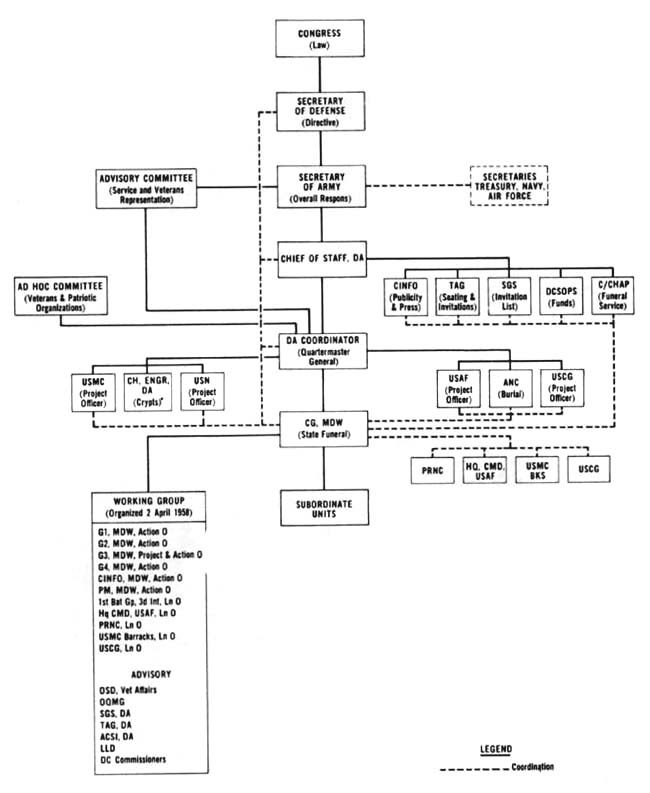
ment. By 16 January 1958
a second draft of the plan was published and sent to the White House,
to all services, and to pertinent commands and staffs for final review
and concurrence. This draft was approved with only minor modifications
and on 12 May 1958 the final version was published.
[95]

OPENING OF
THE SELECTION CEREMONY AT EPINAL, FRANCE, above.
General O'Neil places a wreath to designate his choice, below.
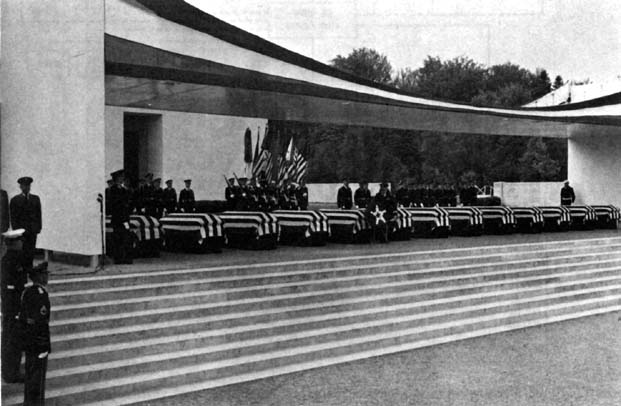
[96]
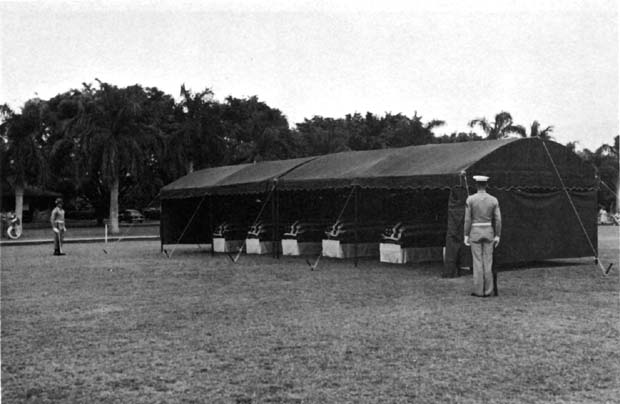
FLAG-DRAPED
CASKETS OF UNKNOWN DEAD LIE AT HICKAM AIR FORCE BASE, above.
Colonel Eggleston designates choice by placing lei on one casket, below.
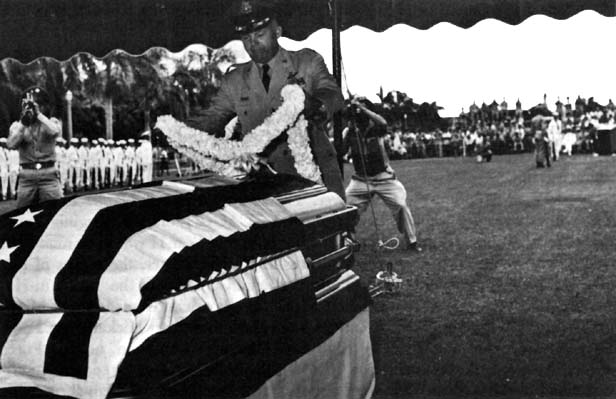
[97]
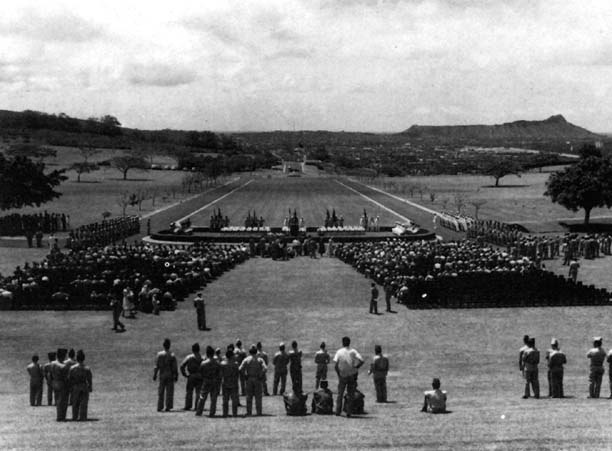
SELECTION
CEREMONY FOR THE UNKNOWN SOLDIER OF THE KOREAN WAR
While planning went on
in Washington, the selection process began overseas. The bodies of thirteen
unknown American servicemen who had fought in the transatlantic phase
of World War II were exhumed at cemeteries in Europe and Africa and
shipped in identical caskets to the US cemetery at Epinal, France. On
12 May Maj. Gen. Edward J. O'Neill, representing the Commander in Chief,
US Army, Europe, chose one of these; the others were reburied. The casket
selected was flown to Naples, Italy, where it was transferred to the
USS Blandy (DD-943), an Atlantic Fleet destroyer. The Blandy
then left Naples to rendezvous with the missile cruiser USS Canberra
(CAG-2) off the Virginia capes where the final choice of the unknown
soldier of World War II was to be made.
In the selection of the serviceman from the Pacific theater, the bodies
of two unknown Americans were taken from the National Cemetery of the
Pacific in Hawaii and four were taken from the Fort McKinley American
Cemetery and Memorial in the Philippines. The six caskets were then
moved to Hickam Air Force Base, Hawaii, where on 16 May 1958 Col. Glenn
T. Eagleston, an Air Force officer, chose one. A day earlier, on 15
May, the bodies of four unknown Americans killed in the Korean War were
removed from the National Cemetery of the
[98]
Pacific, and M. Sgt. Ned
Lyle of the Army chose the one to be honored as the unknown soldier
of the Korean War. The two caskets selected were flown to Guantanamo
Bay, Cuba; the others were buried in Hawaii. In Cuba the caskets were
placed aboard the USS Boston (CAG-I), which then sailed for the
waters off the Virginia capes for the selection of the unknown soldier
of World War II.
The Blandy, Canberra,
and Boston rendezvoused off the Virginia capes on 26 May.
First the casket of the unknown serviceman from the European theater
of World War II was transferred from the Blandy to the Boston.
The two World War II dead and the Korean War dead then were transferred
from the Boston to the Canberra and taken to the Canberra's
missile-handling room. Three morticians from Washington, DC, removed
the steel caskets from their shipping cases, took turns changing the
positions of the caskets bearing the two World War II dead, and transferred
the bodies of all three soldiers to bronze caskets in preparation for
the selection ceremony.
To open the ceremony, the
Canberra's band played Chopin's "Funeral March" as
white-clad sailors wearing black armbands brought the caskets on deck.
The Korean War serviceman was placed directly in front of Hospital Corpsman
1st Class William R. Charette, who had won the Medal of Honor during
the Korean War, and who was to choose the unknown soldier of World War
II. The caskets bearing the World War II dead were placed on either
side of the casket of the Korean War soldier. After brief speeches by
Navy officials, Charette marched to his left around the row of caskets,
saluted, then lifted a floral wreath from a nearby stand, and marched
back to face the caskets astern. After glancing left, he stepped to
the right, placed the wreath at the casket to denote his selection,
and saluted.
Following the selection
ceremony, the caskets of the Korean War and World War II servicemen
were transferred to the Blandy which, escorted by the USCG Ingham
(WPG-35), sailed for the Naval Gun Factory in Washington, DC The
World War II soldier not chosen was then prepared for burial at sea
while the Canberra moved eight miles offshore to meet the requirements
for deep sea burial. As the body was committed to the sea, the bugler
sounded taps and eight marines fired three volleys. The bugler then
blew release and the Canberra turned back toward shore.
Plans for the Washington
rites meanwhile had been completed, and between 12 and 23 May every
ceremony, including one in full dress, and every administrative function
had been rehearsed at least twice. Some phases, such as traffic and
parking control, were rehearsed four times. For the lying in state ceremony
at the Capitol, the US Capitol Architect had provided the Lincoln catafalque
and a second catafalque, identical in dimensions and drapings, that
had been built at Fort Myer under supervision of the Military District
of Washington. The two crypts at the Tomb of the Unknown Soldier also
had been completed.
The Blandy arrived
at the Naval Gun Factory at 1235 on 27 May. She was
[99]
TABLE
5—TROOP LIST, ARRIVAL CEREMONY AT THE NAVAL GUN FACTORY
FOR THE UNKNOWN SOLDIERS OF WORLD WAR II AND THE KOREAN WAR
|
Duty
|
US
Army
|
US
Marine Corps
|
US
Navy
|
US
Air
Force
|
US
Coast Guard
|
Total
|
|
Offi-cers
|
En-
listed Men
|
Offi-
cers
|
En-
listed Men
|
Offi-
cers
|
En-
listed Men
|
Offi-
cers
|
En-
listed
Men
|
Offi-
cers
|
En-
listed
Men
|
Offi-
cers
|
En-
listed Men
|
| Escort
commander and staff |
1
|
|
|
|
|
|
|
|
|
|
1
|
|
| Special
honor guard |
2
|
|
2
|
|
2
|
|
3
|
|
2
|
|
11
|
|
| Commander
of troops and staff |
|
|
|
|
1
|
|
|
|
|
|
1
|
|
| Honor cordon |
|
20
|
|
20
|
|
20
|
|
20
|
|
|
|
80
|
| National
color detail |
|
2
|
|
1
|
|
1
|
|
1
|
|
1
|
|
6
|
| Clergy |
2
|
|
|
|
1
|
|
1
|
|
|
|
4
|
|
| Body bearers |
|
4
|
|
2
|
|
2
|
|
2
|
|
2
|
|
12
|
| Band |
|
|
|
|
1
|
56
|
|
|
|
|
1
|
56
|
| Saluting
battery |
|
|
|
|
2
|
20
|
|
|
|
|
2
|
20
|
| Security
cordon |
|
|
|
|
10
|
400
|
|
|
|
|
10
|
400
|
| Floral
detail |
1
|
2
|
|
|
|
|
|
|
|
|
1
|
2
|
| Communications |
|
|
|
|
1
|
4
|
|
|
|
|
1
|
4
|
| Total |
6
|
28
|
2
|
23
|
18
|
503
|
4
|
23
|
2
|
3
|
32
|
580
|
moored stern in, starboard
side to the south edge of Pier 1. A special gangplank was installed
and other ceremonial fittings were erected. The caskets of the two unknown
servicemen, accompanied by a guard of honor, then were brought from
below to the fantail ceremonial area in preparation for the reception
ceremony the next day.
On 28 May troops and officials
began to take stations for the ceremony at 0840. (Table 5) Aboard
ship sailors manned the rail while officers and petty officers formed
ranks aft. On Pier l the commander of troops placed military participants
at parade rest, and the US Navy Band played hymns as attending dignitaries,
led by the Secretaries of Defense and the Treasury, took their places.
(Diagram 17) The colors arrived next and were presented to the
honor cordon, the assembled dignitaries, and the unknown soldiers. At
0925, as the Navy Band concluded the hymns, the body bearers, divided
into two groups, each led by two chaplains, boarded the ship to remove
the caskets. All troops saluted when the bearers were in position. The
Navy Band sounded four ruffles and flourishes, then played hymns as
the caskets were borne from the Blandy; the World War II unknown
soldier was taken ashore first. The caskets were carried to hearses
at the end of the pier and placed inside simultaneously. Following another
salute, participating dignitaries entered their automobiles and the
procession started toward the Capitol. A 21-gun salute was fired by
a Navy battery as the procession departed. (Diagram 18)
[100]
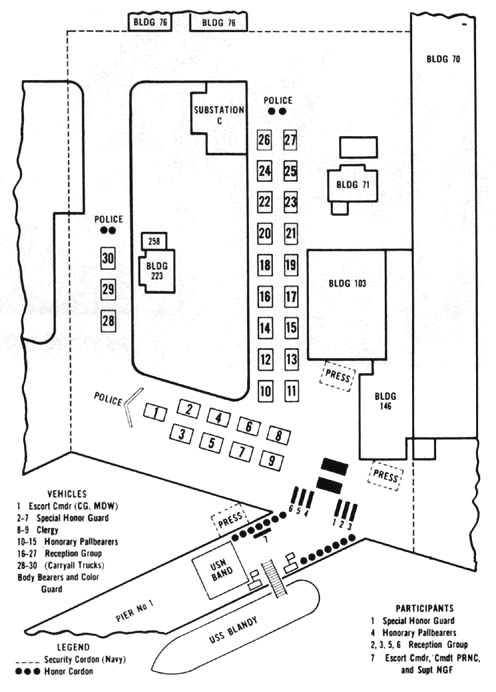
Diagram 17.
Reception formation at the Naval Gun Factory, Washington, DC
[101]
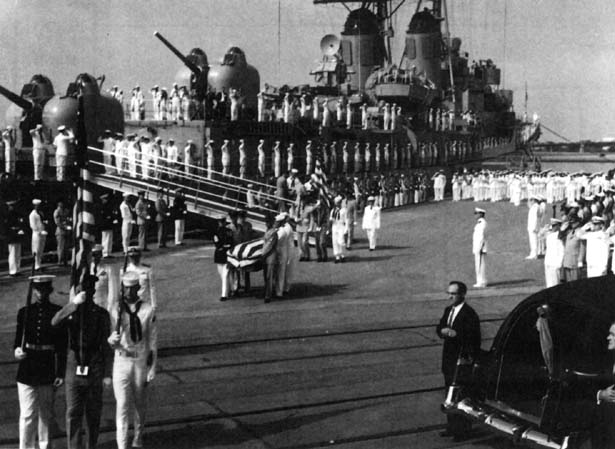
CASKET ARE
CARRIED FROM THE USS BLANDY
The procession moved up
Dahlgren Avenue to M Street, then by way of M Street and New Jersey
Avenue to the East Plaza of the Capitol, entering from the south. (Diagram
19) The body bearers and national color details preceded the cortege
to the Capitol under separate police escort in order to arrive in time
to meet the procession.
At the Capitol participants
in the ceremonies were in place by 0945. (Table 6) A joint honor
cordon of all services formed a corridor up the east steps to the rotunda.
The twelve body bearers waited at the bottom of the steps behind the
color details as the US Air Force Band drew up opposite them. (Diagram
20) Inside the rotunda, standing six deep in a semicircle around
the south end were about 150 members of Congress, officials of executive
departments, justices of the Supreme Court, members of the diplomatic
corps, officials of the District of Columbia, the press, and a large
group from the armed forces. The two catafalques were in the center
of the rotunda. (Diagram 21)
The cortege arrived at 0944.
After the members had left their cars and were in place to proceed up
the steps to the rotunda, the honor guard presented arms, and the Air
Force Band sounded four ruffles and flourishes before beginning a hymn.
[102]
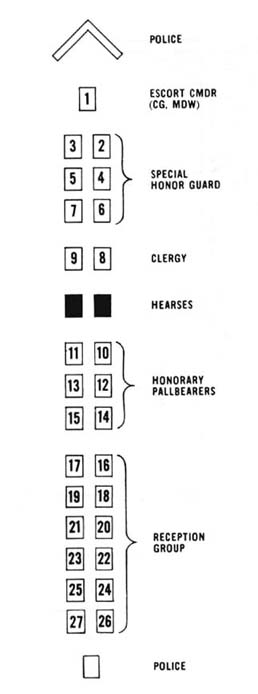
Diagram 18.
Order of march, Naval Gun Factory to the Capitol.
[103]
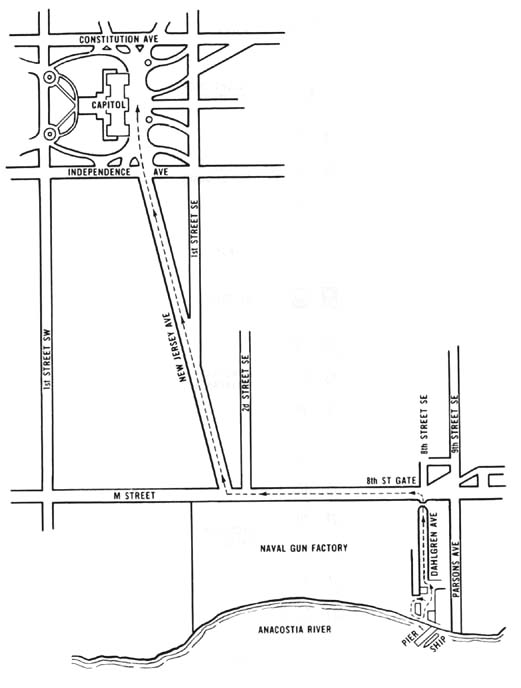
Diagram 19.
Route of march, Naval Gun to the Capitol.
[104]
TABLE
6—TROOP LIST, ARRIVAL CEREMONY AT THE U.S. CAPITOL
FOR THE UNKNOWN SOLDIERS OF WORLD WAR II AND THE KOREAN WAR
|
Duty
|
US
Army
|
US
Marine Corps
|
US
Navy
|
US
Air Force
|
US
Coast Guard
|
Total
|
|
Officers
|
En-
listed Men
|
Officers
|
En-
listed Men
|
Officers
|
En-
listed Men
|
Officers
|
En-
listed Men
|
Officers
|
En-
listed Men
|
Officers
|
En-
listed Men
|
| Escort commander and
staff |
1
|
|
|
|
|
|
|
|
|
|
1
|
|
| Special honor guard |
2
|
|
2
|
|
2
|
|
3
|
|
2
|
|
11
|
|
| Commander of troops
and staff |
1
|
|
|
|
|
|
|
|
|
|
1
|
|
| Honor cordon |
|
12
|
|
12
|
|
12
|
|
12
|
|
12
|
|
60
|
| National color detail |
|
2
|
|
1
|
|
1
|
|
1
|
|
1
|
|
6
|
| Clergy |
2
|
|
|
|
1
|
|
1
|
|
|
|
4
|
|
| Body bearers |
|
4
|
|
2
|
|
2
|
|
2
|
|
2
|
|
12
|
| Band |
|
|
|
|
|
|
1
|
56
|
|
|
1
|
56
|
| Guard of honor |
1
|
9
|
1
|
9
|
1
|
9
|
1
|
9
|
1
|
9
|
5
|
45
|
| Floral detail |
1
|
2
|
|
|
|
|
|
|
|
|
1
|
2
|
| Communications |
1
|
4
|
|
|
|
|
|
|
|
|
1
|
4
|
| Information desk |
1
|
1
|
|
|
|
|
|
|
|
|
1
|
1
|
| Total |
10
|
34
|
3
|
24
|
4
|
24
|
6
|
80
|
3
|
24
|
26
|
186
|
As the hymn was played,
the body bearers removed the caskets from the hearses and formed a column
led by the clergy, with the unknown soldier of World War II to the front.
(Diagram 22) The procession passed through the joint honor cordon
at a slow cadence, and when it entered the rotunda divided to the right
and left. The color details and body bearers made a semicircle to the
rotunda's far side then turned back to the catafalques in the center
of the hall. The clergy meanwhile took their positions at the foot of
the biers. The caskets were then placed on the biers, the bearers were
dismissed, and the first relief of the guard of honor was posted. (Diagram
23)
The honor guard comprised
five reliefs and included troops from the Army, Navy, Marine Corps,
Air Force, and Coast Guard. Each relief had four enlisted sentinels,
a noncommissioned or petty officer, and a commissioned officer. (Table
7) A relief stood a one-hour tour, its members alternating between
the positions of attention and parade rest. Off-duty reliefs were billeted
in a room directly beneath the rotunda.
Vice President Richard M.
Nixon, as president of the Senate, was escorted by an Army officer to
a position directly in front of the caskets. An enlisted man acting
as one of the wreath bearers met him and assisted him in placing a wreath
at the head of the biers. After they had withdrawn, Speaker of the House
Sam Rayburn and the dean of the diplomatic corps, Dr. Guillermo Sevilla-Sacasa
of
[105]
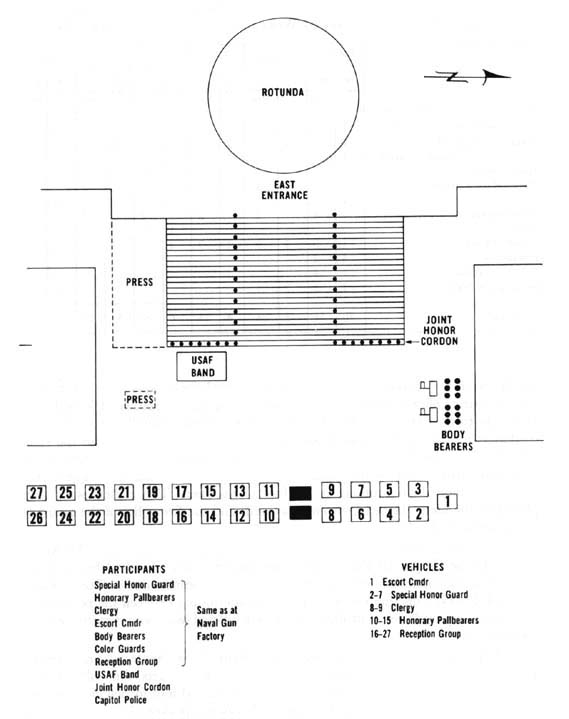
Diagram 20.
Arrival ceremony at the Capitol.
[106]
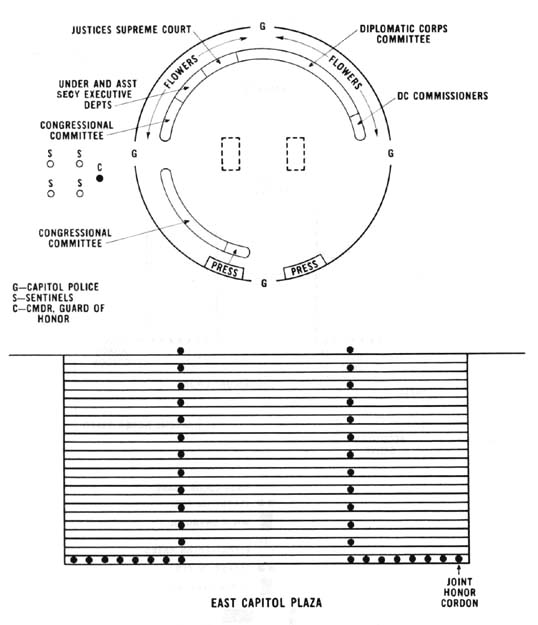
Diagram 21.
Positions for the ceremony in the rotunda.
Nicaragua, also placed wreaths.
Shortly after the wreath-laying ceremony ended, the public was
admitted to the rotunda.
The unknown dead lay in
state from midmorning on 28 May to 1300 on 30 May. Tributes of flowers
were accepted and arranged in the rotunda throughout this period. At
1200 on 29 May the caskets were switched so that the serviceman
[107]
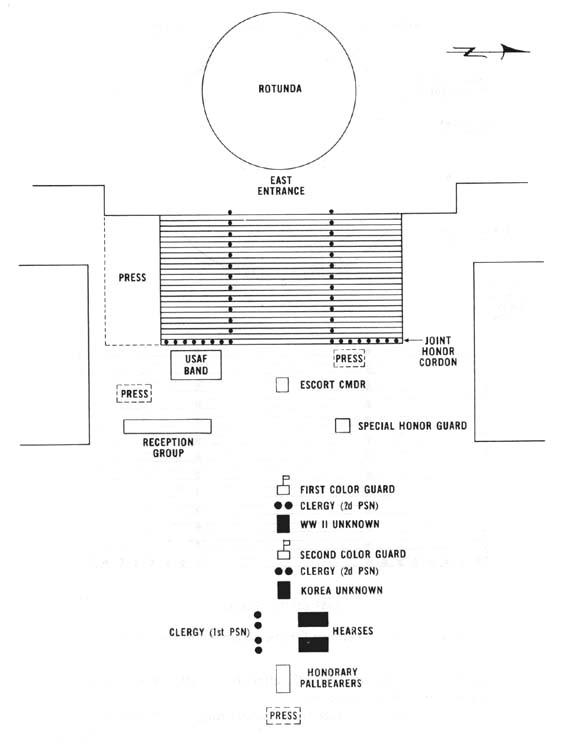
Diagram 22.
Formation of the procession in the rotunda.
[108]
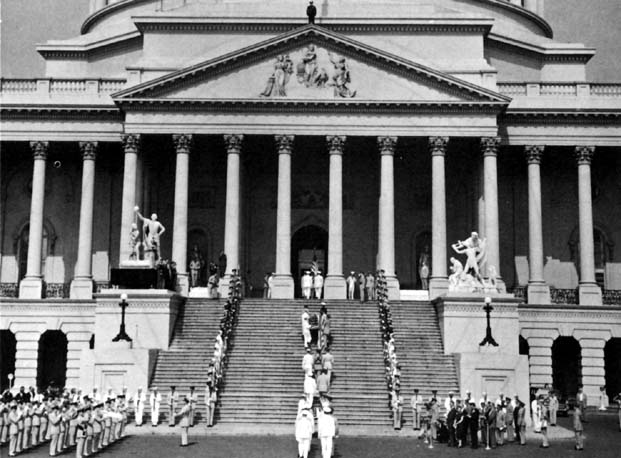
CASKET ARE
CARRIED INTO THE CAPITOL
TABLE
7-TROOP LIST, LYING IN STATE PERIOD FOR THE UNKNOWN
SOLDIERS OF WORLD WAR II AND THE KOREAN WAR
|
Duty
|
US
Army
|
US
Marine Corps
|
US
Navy
|
US
Air Force
|
US
Coast Guard
|
Total
|
|
Officers
|
En-
listed Men
|
Officers
|
En-
listed Men
|
Offi-
cers
|
En-
listed Men
|
Offi-
cers
|
En-
listed Men
|
Offi-
cers
|
En-
listed
Men
|
Officers
|
En-
listed
Men
|
| Commander of troops
and staff |
1
|
|
|
|
|
|
|
|
|
|
1
|
|
| Guard of
honor |
1
|
9
|
1
|
9
|
1
|
9
|
1
|
9
|
1
|
9
|
5
|
45
|
| Floral detail |
5
|
19
|
|
|
|
|
|
|
|
|
5
|
19
|
| Information desk |
3
|
7
|
1
|
1
|
1
|
1
|
1
|
1
|
1
|
1
|
7
|
11
|
| Total |
10
|
35
|
2
|
10
|
2
|
10
|
2
|
10
|
2
|
10
|
18
|
75
|
[109]
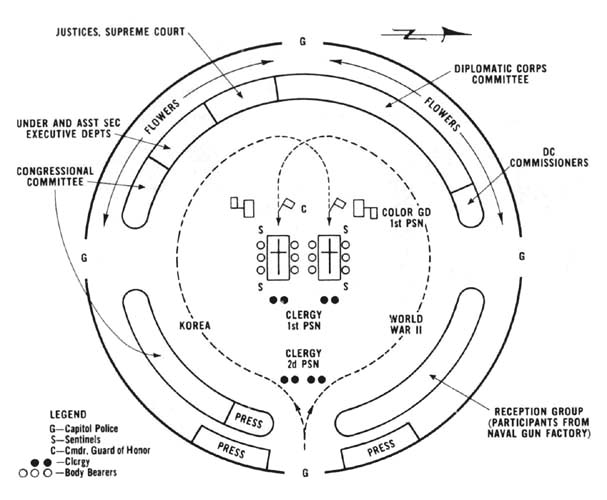
Diagram 23.
Movements of the procession in the rotunda.
of the Korean War rested
on the Lincoln catafalque. At the same time, the catafalques were moved
so that the World War II soldier kept the senior position on the right.
The public was admitted to the rotunda from 1000 until 1900 on 28 May
and from 0800 on 29 May until 1200 on the 30th.
On 30 May in preparation
for the procession, the caisson detail of the 3d Infantry left Fort
Myer for the Capitol at 0730. At the same time, troops of the 3d Infantry
moved into Arlington National Cemetery to prepare for traffic and parking
control. Some 250 officers and men were to occupy fifty-one posts to
cope with the 14,000 cars expected. The 400 officers and men of the
regiment who were to man rope and security cordons also arrived early.
Part of them formed a cordon around the Memorial Amphitheater to keep
the ceremonial area clear and later to direct movement from the amphitheater
to the Tomb of the Unknown Soldier. The rest manned a rope cordon along
Roosevelt Drive, the route of the procession. In all, troops manned
about six miles of rope.
[110]
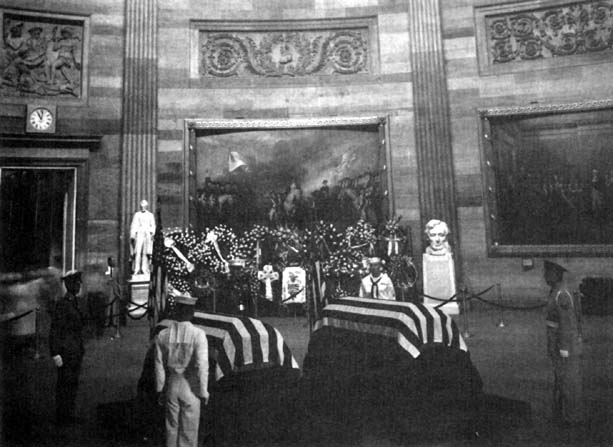
UNKNOWN SOLDIERS
LIE IN STATE IN THE CAPITOL ROTUNDA
Twenty-four different kinds
of parking stickers and seating tickets had been printed and distributed
in order to allow guests to park and to be seated in the most expeditious
manner. Since the cemetery lacked parking spaces for everyone, arrangements
were made for shuttle buses to run between the Pentagon parking lots
and the amphitheater. Of 3,000 seating tickets distributed, which approximated
the capacity of the amphitheater, all went to members of Congress, the
diplomatic corps, ranking military officials, press representatives,
Medal of Honor holders, and veteran and patriotic groups. Both the Pentagon
and the veteran's affairs adviser for the District of Columbia were
besieged with requests for tickets from mothers or widows of men lost
in the war—provisions had been made for mothers and widows during ceremonies
for the Unknown Soldier of World War I —but all seats had been allocated.
Medical aid was available
during all phases of the ceremonies. The Potomac River Naval Command
provided medical facilities at the Naval Gun Factory. During the lying
in state rites, the Congressional physician was available during his
working hours, and at other times the Army provided medical care. For
the ceremonies on 30 May, four aid stations were set up, each staffed
by a medical
[111]
officer, nurse, and attendant
and each equipped with supplies and an ambulance. Anyone requiring hospitalization
was to be evacuated to the George Washington University Hospital or
to the US Army Dispensary at Fort Myer medical attendants in sedans
were to follow the procession to Arlington to pick up and treat anyone
who became ill in the ranks of marchers. (As it turned out, some forty
servicemen and women in the procession were overcome by the heat; others
collapsed at the amphitheater, among them Supreme Court Justice Charles
E. Whittaker. )
The General Services Administration
had also provided five comfort stations in various buildings along the
route of the procession, and the National Park Service had furnished
two within buildings, three mobile stations along the route of march,
and a station at the amphitheater.
Of the signal communications
established, a radio net connected the Capitol and the amphitheater
with net control at the Washington Monument grounds. Motor messengers
were available at each radio station. Wire communications were established
in four information booths at the cemetery and at the information desk
in the rotunda of the Capitol.
Photographic coverage, both
still and motion, was arranged. The Army covered all ceremonies except
the arrival at the Naval Gun Factory, which was photographed by the
Navy.
TABLE
8—TROOP LIST, DEPARTURE CEREMONY AT THE US CAPITOL
FOR THE UNKNOWN SOLDIERS OF WORLD WAR II AND THE KOREAN WAR
|
Duty
|
US
Army
|
US
Marine Corps
|
US
Navy
|
US
Air Force
|
US
Coast Guard
|
Total
|
|
Officers
|
En-
listed Men
|
Officers
|
En-
listed Men
|
Officers
|
En-
listed Men
|
Officers
|
|
Officers
|
En-
listed
Men
|
Officers
|
En-
listed
Men
|
| Escort commander and
staff |
1
|
|
|
|
|
|
|
|
|
|
1
|
|
| Special honor guard |
2
|
|
2
|
|
2
|
|
3
|
|
2
|
|
11
|
|
| Commander of troops
and staff |
1
|
|
|
|
|
|
|
|
|
|
1
|
|
| Honor cordon |
|
12
|
|
12
|
|
12
|
|
12
|
|
12
|
|
60
|
| National color detail |
|
2
|
|
1
|
|
1
|
|
1
|
|
1
|
|
6
|
| Clergy |
2
|
|
|
|
1
|
|
1
|
|
|
|
4
|
|
| Body bearers |
|
4
|
|
2
|
|
2
|
|
2
|
|
2
|
|
12
|
| Caisson detail |
|
8
|
|
|
|
|
|
|
|
|
|
8
|
| Band |
|
|
|
|
|
|
1
|
56
|
|
|
1
|
56
|
| Saluting battery |
2
|
20
|
|
|
|
|
|
|
|
|
2
|
20
|
| Floral detail |
3
|
33
|
|
|
|
|
|
|
|
|
3
|
33
|
| Drivers |
|
50
|
|
|
|
|
|
|
|
|
|
50
|
| Information desk |
1
|
1
|
|
|
|
|
|
|
|
|
1
|
1
|
| Total |
12
|
130
|
2
|
15
|
4
|
71
|
4
|
15
|
2
|
15
|
24
|
246
|
[112]
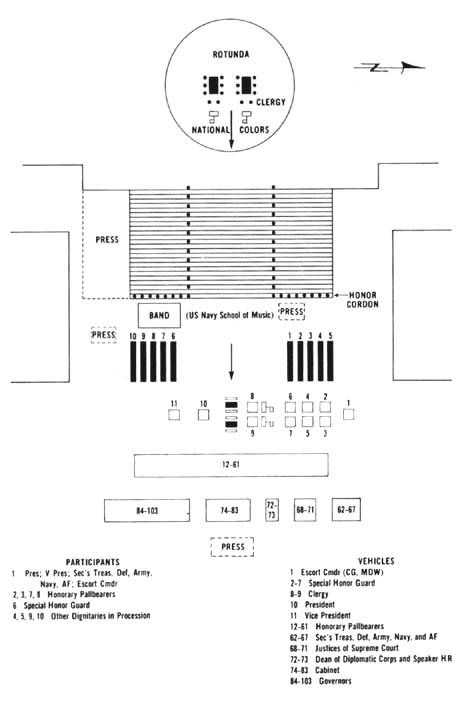
Diagram 24.
Formation of cortege at the Capitol.
[113]
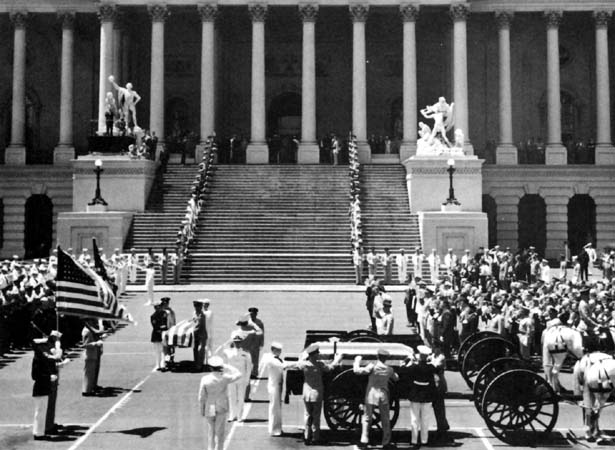
CASKET ARE
PLACED ON CAISSONS
At midmorning on 30 May
a saluting battery from Headquarters, Second US Army, took station on
the Washington Monument grounds where it was to fire a minute-gun salute
during the procession and the ceremony at the cemetery. Escort units
of the main procession began assembling along Delaware Avenue, N.E.,
just north of the Capitol, about noon; the groups that would move as
part of the cortege from the Capitol were in place on the East Plaza
by 1230. (Diagram 24) (Table 8)
At 1259 the
US Naval School of Music Band sounded attention. At 1300 the body bearers
took up the caskets and, with those carrying the unknown soldier of
World War II leading, moved out of the rotunda. At the same moment,
the saluting battery on the Washington Monument grounds began firing
minute guns. The firing continued until the close of ceremonies at the
cemetery except for a pause during two minutes of silence observed at
the amphitheater. The cease-fire signal for the minute guns was the
firing of the first round of the final 21-gun salute at the cemetery.
As the procession moved
out of the rotunda, each casket was preceded by a color guard and two
clergymen. Maj. Gen. Patrick J. Ryan, the Army Chief of
[114]
TABLE 9—TROOP LIST, MAIN PROCESSION FOR THE UNKNOWN
SOLDIERS
OF WORLD WAR II AND THE KOREAN WAR
|
Duty
|
US
Army
|
US
Marine Corps
|
US
Navy
|
US
Air Force
|
US
Coast Guard
|
Total
|
|
Officers
|
En-
listed Men
|
Officers
|
En-
listed Men
|
Officers
|
En-
listed Men
|
Officers
|
En-
listed Men
|
Officers
|
En-
listed Men
|
Officers
|
En-
listed
Men
|
| Escort commander
and staff |
1
|
|
|
|
|
|
|
|
|
|
1
|
|
| Special honor guard |
2
|
|
2
|
|
2
|
|
3
|
|
2
|
|
11
|
|
| Commander of troops
and staff |
2
|
|
1
|
|
1
|
|
1
|
|
1
|
|
6
|
|
| National color detail |
|
2
|
|
1
|
|
1
|
|
1
|
|
1
|
|
6
|
| Clergy |
2
|
|
|
|
1
|
|
1
|
|
|
|
4
|
|
| Body bearers |
|
4
|
|
2
|
|
2
|
|
2
|
|
2
|
|
12
|
| Caisson detail |
|
8
|
|
|
|
|
|
|
|
|
|
8
|
| Band |
1
|
99
|
|
|
1
|
99
|
1
|
99
|
|
|
3
|
297
|
| Military escort |
|
|
|
|
|
|
|
|
|
|
|
|
| Active |
6
|
85
|
5
|
85
|
5
|
85
|
5
|
85
|
5
|
85
|
26
|
425
|
| Cadet |
4
|
85
|
|
|
4
|
85
|
|
|
|
|
8
|
170
|
| Servicewomen |
1
|
19
|
1
|
19
|
1
|
19
|
1
|
19
|
|
|
4
|
76
|
| Army National Guard |
6
|
85
|
|
|
|
|
|
|
|
|
6
|
85
|
| Army Reserve |
5
|
85
|
|
|
|
|
|
|
|
|
5
|
85
|
| Marine Reserve |
|
|
5
|
85
|
|
|
|
|
|
|
5
|
85
|
| Navy Reserve |
|
|
|
|
5
|
85
|
|
|
|
|
5
|
85
|
| Air National Guard |
|
|
|
|
|
|
5
|
85
|
|
|
5
|
85
|
| Air Force Reserve |
|
|
|
|
|
|
5
|
85
|
|
|
5
|
85
|
| Coast Guard Reserve |
|
|
|
|
|
|
|
|
5
|
85
|
5
|
85
|
| Street cordon |
13
|
490
|
12
|
490
|
13
|
490
|
13
|
490
|
|
|
51
|
1,960
|
| Drivers |
|
50
|
|
|
|
|
|
|
|
|
50
|
|
| Communications |
1
|
6
|
|
|
|
|
|
|
|
|
1
|
6
|
| Total |
44
|
1,018
|
26
|
682
|
33
|
866
|
35
|
866
|
13
|
173
|
151
|
3,605
|
Chaplains, and Rear Adm.
Edward B. Harp, the Navy Chief of Chaplains, walked ahead of the World
War II unknown soldier and Maj. Gen. Charles I. Carpenter, the Air Force
Chief of Chaplains, and Lt. Col. Philip Pincus, Air Force chaplain,
ahead of the unknown soldier of the Korean War. The procession halted
at the top of the steps while the US Navy Band sounded four ruffles
and flourishes and then began a hymn. During the hymn the procession
descended the steps and the caskets were secured to the caissons.
Once the caskets were in
place, the band stopped playing and the clergy entered automobiles in
front of the caissons. The color details took post ten paces ahead of
the clergy, while the body bearers stationed themselves three on each
side of each caisson. The cortege then moved north from the plaza to
join the escort of the procession on Constitution Avenue. (Table
9)
[115]
The full procession
started toward the cemetery a few minutes after 1300 and moved via Constitution
Avenue, 23d Street, Memorial Bridge, and Memorial Drive. Along the route
was a joint honor cordon composed of Army, Navy, Marine, and Air Force
troops. (Diagrams 25 and 26) When the procession arrived at the
cemetery the caissons, which had been moving abreast, shifted into a
column led by the caisson bearing the World War II Unknown Soldier.
As the
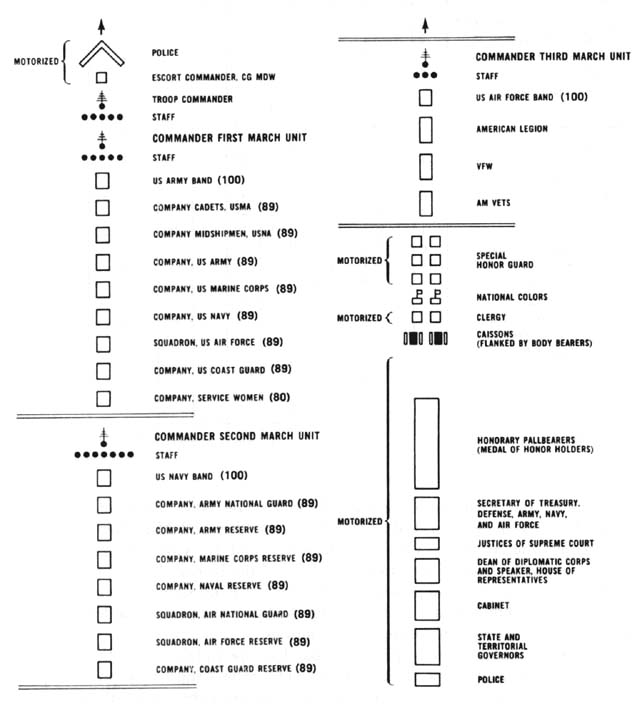
Diagram 25.
Order of march, procession from the Capitol to Arlington National Cemetery.
[116]
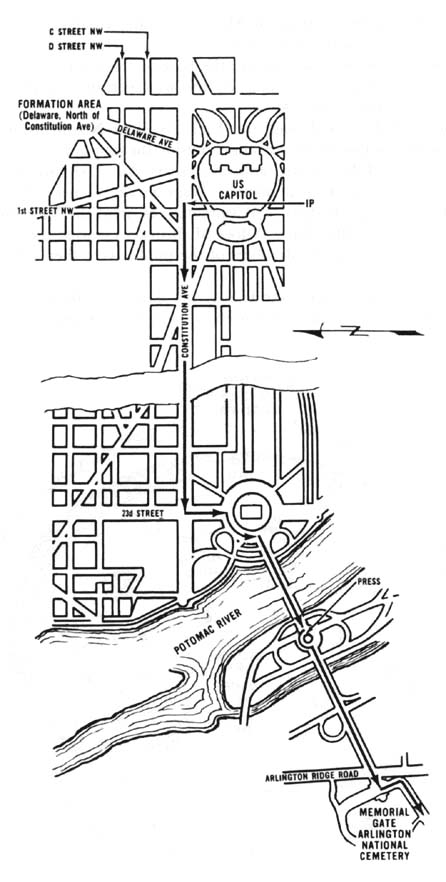
Diagram 26.
Route of march, Capitol to Arlington National Cemetery.
[117]
caissons entered the cemetery
through Memorial Gate, twenty jet fighters and bombers passed overhead
with one plane missing from each formation (a ceremonial feature used
for the first time during the funeral for General Hoyt S. Vandenberg
in 1954). The procession reached the west entrance of the Memorial Amphitheater
at approximately 1440.
President Dwight D. Eisenhower
and Vice President Nixon meanwhile had arrived from the White House
but remained outside the amphitheater until dignitaries in the cortege
had dismounted and taken seats. All others invited to attend the ceremony
were already in their places. (Diagram 27) General Van Houten,
commander of the Military District of Washington, escorted the Vice
President to his seat, while Secretary of the Army Wilber M. Brucker
escorted the President to his; both seats were in the apse. Members
of the public were then allowed to fill any unoccupied spots.
After the audience was seated,
the US Army Band outside the amphitheater played four ruffles and flourishes,
followed by a hymn. During the hymn the
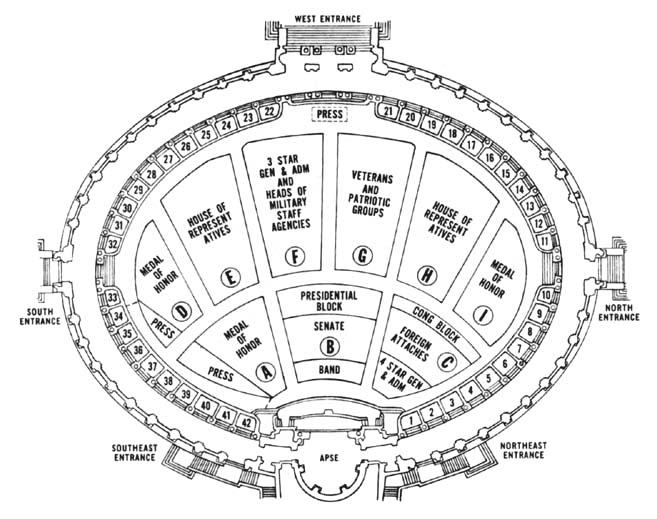
Diagram 27.
Memorial Amphitheater seating plan.
[118]
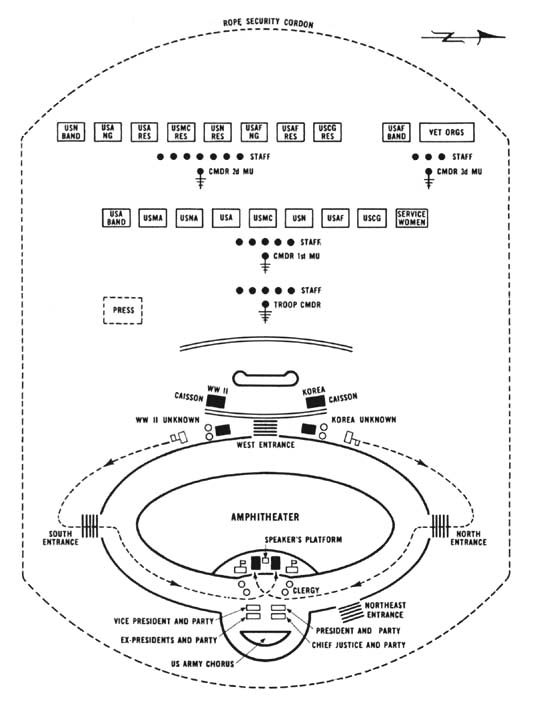
Diagram 28.
Arrival ceremony at Memorial Amphitheater.
[119]
bearers removed the caskets
from the caissons and, led as before by clergy and colors, carried them
inside. The Unknown Soldier of World War II was borne through the south
entrance and the Korean War Unknown Soldier through the entrance on
the north. Just inside the amphitheater, each casket was set on a movable
bier and wheeled around the colonnade to the apse, where the World War
II Unknown Soldier was placed in front of President Eisenhower and the
Korean War Unknown Soldier in front of Vice President Nixon. While the
caskets were being brought to the apse, the US Marine Band, seated in
the amphitheater, played religious music. After the caskets were situated,
the Marine Band played the national anthem. (Diagram 28)
The Army Chief
of Chaplains, General Ryan, then delivered the invocation. At its conclusion
a bugler sounded attention three times and a two-minute period of silence
followed. The Army Chorus and the audience sang "America,"
after which President Eisenhower arose and placed a Medal of Honor on
each casket. The reading of scripture and singing to religious music
followed. (Table 10) As the funeral service was brought to a
close by the Marine Band's postlude, the Unknown Soldiers were taken
to the amphitheater's Trophy Room. The Presidential party also withdrew
to the Trophy Room, while the audience made its way to the plaza at
the Tomb of the Unknown Soldier for the burial service.
TABLE
10—TROOP LIST, FUNERAL SERVICE FOR THE UNKNOWN
SOLDIERS OF WORLD WAR II AND THE KOREAN WAR
|
Duty
|
US
Army
|
US
Marine
Corps
|
US
Navy
|
US
Air
Force
|
US
Coast
Guard
|
Total
|
|
Offi-
cers
|
En-
listed
Men
|
Offi-
cers
|
En-
listed
Men
|
Offi-
cers
|
En-
listed
Men
|
Offi-
cers
|
En-
listed
Men
|
Offi-
cers
|
En-
listed
Men
|
Offi-
cers
|
En-
listed
Men
|
| Escort commander and
staff |
1
|
|
|
|
|
|
|
|
|
|
1
|
|
| Special honor guard |
2
|
|
2
|
|
2
|
|
3
|
|
2
|
|
11
|
|
| National color detail |
|
2
|
|
1
|
|
1
|
|
1
|
|
1
|
|
6
|
| Clergy |
2
|
|
|
|
1
|
|
1
|
|
|
|
4
|
|
| Body bearers |
|
4
|
|
2
|
|
2
|
|
2
|
|
2
|
|
12
|
| Band |
|
|
1
|
56
|
|
|
|
|
|
|
1
|
56
|
| Chorus |
1
|
30
|
|
|
|
|
|
|
|
|
1
|
30
|
| Site Control |
20
|
|
|
|
|
|
|
|
|
|
20
|
|
| Security cordon |
6
|
372
|
|
|
|
|
|
|
|
|
6
|
372
|
|
Ushers
|
4
|
45
|
3
|
44
|
2
|
42
|
2
|
42
|
2
|
15
|
13
|
188
|
|
Guides
|
21
|
|
|
|
|
|
|
|
|
|
21
|
|
|
Floral
detail
|
3
|
33
|
|
|
|
|
|
|
|
|
3
|
33
|
|
Communications
|
1
|
4
|
|
|
|
|
|
|
|
|
1
|
4
|
|
Information
desk
|
12
|
40
|
|
|
|
|
|
|
|
|
12
|
40
|
|
Total
|
73
|
530
|
6
|
103
|
5
|
45
|
6
|
45
|
4
|
18
|
94
|
741
|
[120]

PRESIDENT
EISENHOWER PLACES MEDAL OF HONOR ON EACH CASKET
The Unknown Soldiers were
taken from the Trophy Room, in a procession that included the Presidential
party, to the head of the plaza steps. There the procession halted while
the Army Band sounded four ruffles and flourishes. After this salute
the procession descended the steps, and the body bearers placed the
caskets over the crypts. (Diagram 29) They then took hold of
the flags that had draped the caskets and held them taut above the caskets.
Three chaplains, General
Ryan, a Catholic; Admiral Harp, a Protestant; and Colonel Pincus, a
Jew, each conducted the burial service of his faith. The saluting battery
of the 3d Infantry then fired twenty-one guns. At the first round, the
minute-gun battery on the Washington Monument grounds ceased firing.
After the gun salute, a squad of eight from the 3d Infantry fired the
traditional three volleys and, immediately afterward, a 3d Infantry
bugler sounded taps. The body bearers then folded the flags and presented
them to the President and Vice President, who in turn gave them to cemetery
officials for safekeeping. (Table 11)
The presentation of the
flags completed the burial service. After the participants had left
the plaza, the public, guided by members of the 3d Infantry, filed by
the crypts. Later in the evening, about 2100, cemetery superintendent
John C.
[121]

Diagram 29.
Formation for the burial service.
[122]

LAST RITES
IN ARLINGTON NATIONAL CEMETERY
TABLE
11- TROOP LIST, BURIAL SERVICE FOR THE UNKNOWN
SOLDIERS OF WORLD WAR II AND THE KOREAN WAR
|
Duty
|
US
Army
|
US
Marine
Corps
|
US
Navy
|
US
Air
Force
|
US
Coast
Guard
|
Total
|
|
Offi-
cers
|
En-
listed Men
|
Offi-
cers
|
En-
listed
Men
|
Offi-
cers
|
En-
listed
Men
|
Offi-
cers
|
En-
listed
Men
|
Offi-
cers
|
En-
listed
Men
|
Offi-
cers
|
En-
listed
Men
|
| Escort commander and
staff |
1
|
|
|
|
|
|
|
|
|
|
1
|
|
| Special
honor guard |
2
|
|
2
|
|
2
|
|
3
|
|
2
|
|
11
|
|
| Commander of troops
and staff |
1
|
|
|
|
|
|
|
|
|
|
1
|
|
| Honor cordon |
1
|
6
|
|
6
|
|
6
|
|
6
|
|
6
|
1
|
30
|
| Color detail |
|
3
|
|
3
|
|
3
|
|
3
|
|
2
|
|
14
|
|
Clergy
|
2
|
|
|
|
1
|
|
1
|
|
|
|
4
|
|
|
Body
bearers
|
|
4
|
|
2
|
|
2
|
|
2
|
|
2
|
|
14
|
|
Band
|
1
|
56
|
|
|
|
|
|
|
|
|
1
|
56
|
|
Saluting
battery
|
2
|
20
|
|
|
|
|
|
|
|
|
2
|
20
|
|
Firing
party
|
|
8
|
|
|
|
|
|
|
|
|
|
8
|
|
Bugler
|
|
1
|
|
|
|
|
|
|
|
|
|
1
|
| Security cordon |
3
|
172
|
|
|
|
|
|
|
|
|
3
|
172
|
| Floral detail |
3
|
33
|
|
|
|
|
|
|
|
|
3
|
33
|
| Total |
15
|
303
|
2
|
11
|
3
|
11
|
4
|
11
|
2
|
10
|
26
|
346
|
[123]
Metzler and his assistant,
F. A. Lockwood, lowered the caskets. The body bearers stood behind a
guide chain and saluted as the caskets sank into their crypts. This
was the last rite in the ceremonies that throughout the day had involved
some 4,800 members of the armed forces.
The final act, not part
of any planned ceremony, took place on 2 June 1958. On that date, each
crypt was filled with a concrete slab and topped with white marble.
The marble tops bore only dates: 1941-1945 for the Unknown American
of World War II, 1950-1953 for the Unknown American of the Korean War.
At the same time, the dates 1917-1918 were carved in the pavement in
front of the tomb of the Unknown Soldier of World War I.
[124]
Previous
Chapter Next
Chapter
|